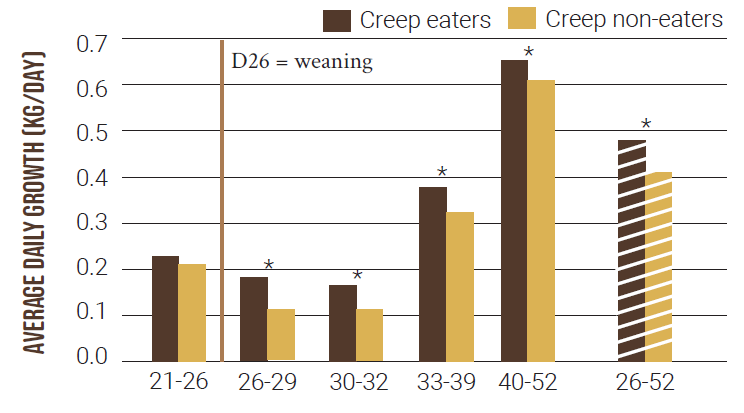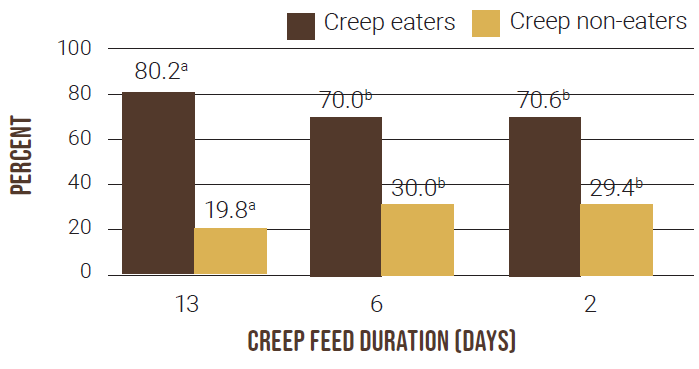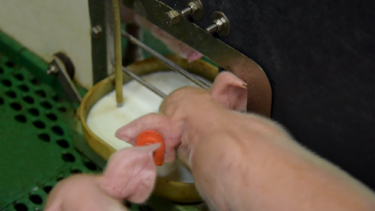The art of liquid feeding
The increasing prolificacy of modern sows is challenging our farmers. With the increasing amount of piglets per sow, piglets are entering the weaning stage lacking the immunity and gut development required to succeed. This raises post-weaning mortality and leads to significant financial losses.
Further reduction of antibiotic use, and in the European Union the ban on medicinal zinc oxide use, makes early life management more critical than ever. Starting piglets early with feed increases growth and reduces health issues, allowing them to successfully overcome the weaning stage. Management of early life feed has made important progress and, as farms are becoming larger, automated liquid prestarter feeding systems have found their way into the farrowing crates. Therefore a feeding range for these specific applications was designed, Babi®mel Care.
Importance of early feed intake and creating eaters
Although the sow can produce more milk per kg of body weight compared to a cow, sow milk is limited in the early stage after farrowing. Plus, the milk provided to her offspring is not able to exploit the genetic potential of the piglets. Larger litters also mean that the larger, often first-born piglets, are the winners when it comes to teat order. Soon after birth, heavier, more vital piglets will select their favorite teat and consume a lot of milk. Putting even more stress on their development, smaller piglets will get the leftovers, typically the lower producing posterior teats. Research has shown that smaller piglets are, relatively to larger piglets, better consumers of creep feed.
Although a creep feed will help smaller piglets and prepare them for weaning, there is still the downside of small piglets consuming less sow colostrum and milk rich in nutrients, prebiotics components, and immunoglobulins. All of these components are essential to their immune and intestinal development. Larger piglets on the other hand will keep drinking sow milk, making them less familiar with creep feed and more vulnerable at the moment of weaning. This can lead to delayed feed intake after weaning, which has an impact on gut health such as villi atrophy, gut barrier failure, and pathogen overgrowth.
The main goal when it comes to young piglet feeding is creating the maximum amount of creep eaters and optimally preparing the gastrointestinal tract (Figure 1). This way, all piglets (big or small) will successfully overcome weaning and perform well later in life.

Automated piglet feeding
Obtaining the objective described above is easier said than done. With years of experience, we are a pioneer in this topic and have developed specific creep feed and prestarter ranges such as Babito® and the Babi® range to obtain these goals. A lot of other management practices can create eaters in the farrowing house, such as the starting time, length (Figure 2), and the frequency the creep feed is offered. Another way of stimulating eating behavior is by differentiating the structure of the feed, such as porridge feed.

Automated porridge feeding offers a lot of advantages to the herd. Not only will it reduce the farmer’s labor costs, but it also enables the piglet to eat and drink freshly made feed multiple times a day. However, care to hygiene and feeding the right products at the right viscosity are indispensable to farm success. With years of intensive field testing, the Babi®mel Care range of three products was designed specifically for automated prestarter systems.
Babi®mel Care, the right product for each phase of life
Aimed to create the maximum amount of eaters by offering highly digestible fat and protein sources, the Babi®mel Care range is a balanced mix of flavors and taste enhancers.
- Babi®mel Care I is a highly attractive complementary feed provided next to sow milk until 10 days of life
- Babi®mel Care II ensures a smooth transition from milk to plant-based raw materials. High-quality extruded cereals prepare the gut until 18 days of age
- Babi®mel Care III maximizes dry matter intake and contains a balanced mix of health-promoting ingredients for a smoother weaning
With this range, sows are relieved from overdemanding piglets and can start recovering for their next parity. The complete range is enriched with the START+ concept. This concept finds its origin in infant nutrition and offers piglet-specific bioactive components that mime the effect of the prebiotics found in sow colostrum and milk. Extensive trials done at universities, research institutes, and field experience is showing that START+ positively develops the gastrointestinal tract. This concept also supports the proliferation of beneficial bacteria, such as lactobacilli and bifidobacterial, as well as improves villi development and increased gut barrier function in newborn piglets to result in better growth and health.
Technical features characterizing the complete Babi®mel Care range are perfect solubility, flow rate, and stability in all types of automated prestarter feeding systems. This leads not only to optimal intake and growth of the piglet but also to increased comfort for the farmer who does not have to worry about sedimentation or clotting. It can be concluded that accurate farrowing feeding management, combined with the right products offering the right nutrients at the right time, will make automated porridge feeding successful on your farm.
This contact was suggested based on the location you are browsing from. You can of course also consult our other contacts and locations here.

